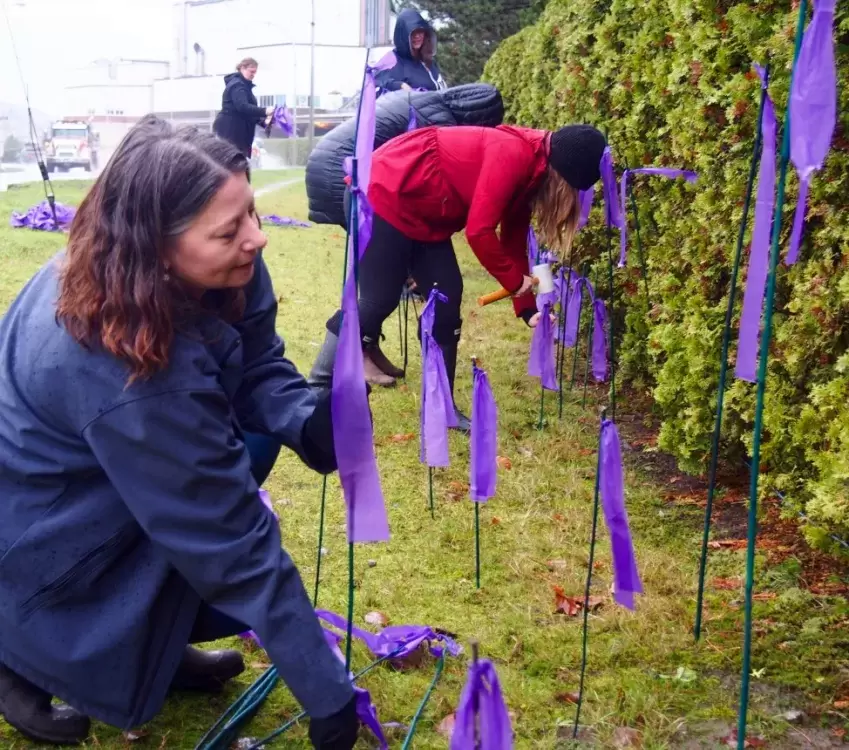Second-stage support housing in Port Alberni promises to narrow a serious gap in regional services for women and children fleeing relationship violence.
The provincial government announced Oct. 25 that it will fund 280 new housing units in support of victims of violence, the first phase of $734 million over 10 years to build 1,500 units provincewide.
Twenty housing units in Port Alberni could be available within a couple of years in the initial phase.
Ellen Frood, executive director of Alberni Community and Women’s Resource Society, said the new housing will extend the society’s ability to support clients beyond the 30-day limit of Port Alberni Transition House, its existing emergency shelter.
“Here in Port Alberni it is an absolutely enormous gap,” Frood said. “We’re just absolutely thrilled by the announcement last Thursday. What it means for women in general is that they will have a safe place to stay,” she added.
ACAWS made second-stage support housing a priority after Frood took the helm a couple of years ago.
Reported cases of relationship violence in Port Alberni have risen steeply in recent years. There were 335 cases reported in 2017, up from 219 in 2016 and 105 in 2015.
In one comparison several years ago, Statistics Canada data indicated that the Port Alberni region had three-and-a-half times the national average of reported incidents.
The city’s RCMP detachment added a domestic violence officer in 2014, an additional resource believed to be a factor in the increased reporting in the last few years. Still, research suggests a majority of incidents are unreported.
Seventy-five percent of ACAWS clients identify as Aboriginal, Frood said. That’s a higher percentage than most B.C. communities partly because the city is home to a greater percentage of Indigenous residents, 16.8 per cent according to the latest Alberni Valley Vital Signs report. ACAWS also takes in clients from outlying communities on the west coast.
Extended services can make the critical difference for victims of violence struggling to rebuild their lives. Often women remain in abusive relationships because they fear loss of income, loss of housing and the inability to feed their children, Frood said.
Capable of providing a home for six to 18 months, the new facility will also offer wrap-around services and greater assurances of successful transitions. Units will be designated for families as well as for single women.
The dozen beds at the existing emergency shelter are sometimes filled to capacity. No clients are left to fend for themselves, meaning some must be referred at times to facilities in other communities. Shelters routinely connect clients with services outside the community, particularly if the move means clients can be closer to family.
“Often times, women will leave a community for safety reasons,” Frood explained.
MLA Scott Fraser welcomed the funding, pledging additional support as the Building B.C.: Women’s Transition Housing Fund rolls out in coming years.
“There’s not been any investment in two decades for women needing transition housing and fleeing violence,” Fraser said. “The calls for that have largely gone unheard and unheeded.”
He credited local agencies such as ACAWS for persistence in pressing the government to improve supports.
“It’s going to benefit Indigenous and non-Indigenous women and children fleeing violence,” he added. “There is no distinction at the door.”
Frood said the lack of affordable housing in many communities has compounded the difficulty for women attempting to get back on their feet. An estimated 500 people in the city can’t find affordable housing. The housing crisis in general was a major issue during this fall’s municipal elections.
“The challenge is for both regional and municipal councils to make housing a priority,” which hasn’t been the case in the past, Frood said.
The support beds project could take two years or more to complete. Capital cost of the new housing is estimated to be in the range of $2 million to $2.5 million, she said.
Frood is planning to approach the newly elected city council to discuss land for the project. She has spoken with B.C. Housing, the funding agency, and was assured they will act on the commitment as soon as possible. Bringing new facilities on stream can take up to five years, she cautioned.
“I’d like to be optimistic and say that’s not the case here,” she said.
Nov. 25 is the International Day to End Violence Against Women. The annual Purple Ribbon Campaign calls attention to the cause with ribbons along Stamp Avenue representing the number of reported cases in the city over the past year.







